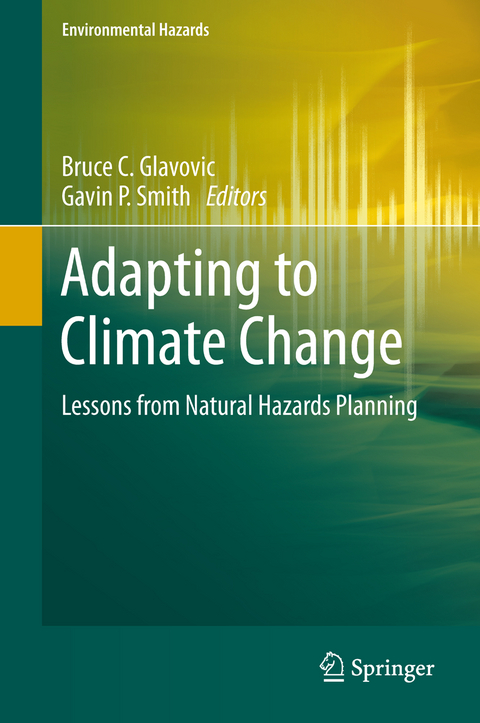
Adapting to Climate Change
Springer (Verlag)
978-94-017-8630-0 (ISBN)
"A theoretically rich and empirically grounded analysis of the interface between disaster risk management and climate change adaptation, comprehensive yet accessible, and very timely." Mark Pelling, Department of Geography, King’s College London, UK.
"This book represents a major contribution to the understanding of natural hazards planning as an urgent first step for reducing disaster risk and adapting to climate change to ensure sustainable and equitable development." Sálvano Briceño, Vice-Chair, Science Committee, Integrated Research on Disaster Risk IRDR, an ICSU/ISSC/ISDR programme. Former Director International Strategy for Disaster Reduction, UNISDR.
“What a welcome addition to the young literature on climate adaptation and hazard mitigation! Bruc
e Glavovic and Gavin Smith each bring to the editing task a rare blend of solid scholarly attainment and on-the-ground experience that shines through in this extensively-documented synthesis of theoretical ideas from the realms of climate and hazards and their validation in a rich set of diverse case studies pulled in from around the world. This book should remain a classic for many years.” William H. Hooke, American Meteorological Society.
Dr. Glavovic has over 25 years of experience in academia, private consulting and Government and has worked mainly in South Africa, the United States of America and New Zealand. He is Vice-Chair of the Land-Oceans Interactions in the Coastal Zone (LOICZ) programme and is leading a UNESCO Intergovernmental Oceanographic Commission Technical Working Group to prepare guidelines for community coastal risk management. He is a contributing author to Working Group II’s chapter on Australasia in the IPCC’s 5th Assessment Report. Dr. Glavovic’s research has been published in a variety of academic and professional journals. He co-edited Integrated Coastal Zone Management: The Global Challenge (2008) and The Ecological Economics of Oceans and Coasts (2008) and Climate Change and the Coast: Building Resilient Communities (In press). Dr. Smith is the Executive Director of the Department of Homeland Security’s Coastal Hazards Center of Excellence. The Coastal Hazards Center research focus areas include: hazard modeling, engineering, human behavior, and land use planning. He is currently engaged in planning-related research within the Center, focused on a national evaluation of local and state hazard mitigation plans. Dr. Smith is an Associate Research Professor in the Department of City and Regional Planning at the University of North Carolina at Chapel Hill. He is author of Planning for Post-Disaster Recovery: A Review of the United States Disaster Assistance Framework (Island Press, 2011). Following Hurricane Katrina, Dr. Smith worked in the Mississippi Office of the Governor, serving as the Director of the Office of Recovery and Renewal. In this role, he and his staff focused on four primary tasks: the identification of federal, corporate, non-profit and foundation financial assistance; the provision of education, outreach and training to local governments and state agencies; providing counsel to the Governor, his staff and state agency officials regarding disaster recovery policy issues and the implementation of the Governor’s Commission Report: After Katrina: Building Back Better than Ever. In this role he testified before Congress twice, providing recommended policy changes to improve the delivery of post-disaster recovery and reconstruction activities. He also developed the concept and wrote policy guidance associated with the 400 million dollar Alternative Housing Pilot Program, an initiative intended to test the construction and deployment of improved emergency housing alternatives following Hurricane Katrina. Dr. Smith served as the Assistant Director for Hazard Mitigation in the State of North Carolina. During his tenure with the Division, the Mitigation Section administered mitigation and disaster recovery grant funds in excess of 800 million dollars associated with 10 Presidential disaster declarations leading the acquisition and relocation or elevation of over 5,000 and 500 homes respectively. Following Hurricane Floyd, Dr. Smith served as an advisor to Governor Hunt on policies and programs associated with long-term recovery in North Carolina, including the development of 22 state programs that addressed local needs not met by federal assistance.
Section 1: Climate change adaptation: Theory and practice.- Section 2: The nature of disasters and the role natural hazards planning in building resilient communities.- Section 3: Lessons from disaster experience.
| Erscheint lt. Verlag | 5.5.2014 |
|---|---|
| Reihe/Serie | Environmental Hazards |
| Zusatzinfo | 55 Illustrations, color; 6 Illustrations, black and white; XX, 461 p. 61 illus., 55 illus. in color. |
| Verlagsort | Dordrecht |
| Sprache | englisch |
| Maße | 155 x 235 mm |
| Themenwelt | Naturwissenschaften ► Biologie ► Ökologie / Naturschutz |
| Naturwissenschaften ► Geowissenschaften ► Geologie | |
| Naturwissenschaften ► Geowissenschaften ► Meteorologie / Klimatologie | |
| ISBN-10 | 94-017-8630-5 / 9401786305 |
| ISBN-13 | 978-94-017-8630-0 / 9789401786300 |
| Zustand | Neuware |
| Informationen gemäß Produktsicherheitsverordnung (GPSR) | |
| Haben Sie eine Frage zum Produkt? |
aus dem Bereich


